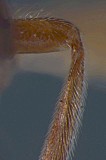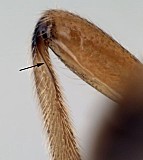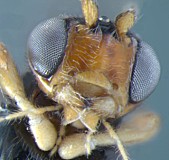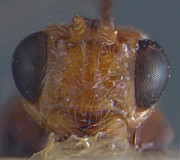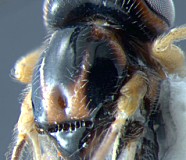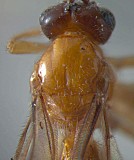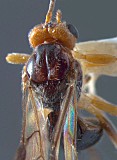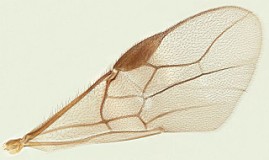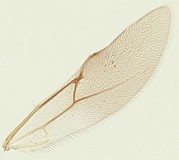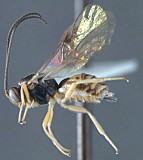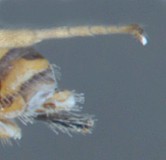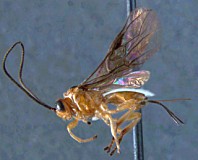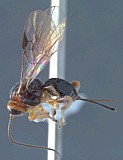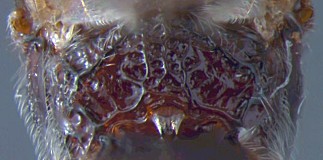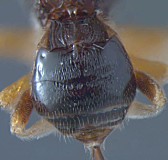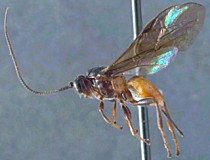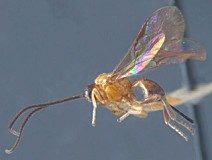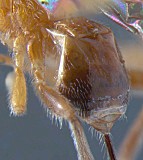The sympatric speciation model developed for hosts in the genus
Rhagoletis has not yet been tested on their parasitoids, many of which belong in the genus
Utetes. Although
Wharton and Marsh (1978) have indicated that some of these parasitoids are less host specific than members of the genus
Rhagoletis, these conclusions are based solely on morphology. Host range testing is needed; and a population genetics approach to assessment of host specificity would be fruitful. It would be particularly interesting to determine whether the tropical species of
Utetes show the same level of host specificity as temperate species.
Identification of Species Groups (each species group is treated separately below)
1a. Occipital carina absent. Neotropical, with one species introduced to Florida…
Utetes anastrephae species group.
1b. Occipital carina present and well developed laterally. Nearctic and Old World…Go to couplet 2.
2a. Second metasomal tergum with distinct sculpture (usually carinate or somewhat rugose) (Fig. 10: bianchii)… Utetes bianchii species group.
2b. Second abdominal tergum smooth or with basal pits (Fig. 15:
perkinsi)…
Utetes truncatus species group.
The Utetes anastrephae species group
The Neotropical species placed by
Fischer (1977) in
Bracanastrepha form a distinct species group based on the complete loss of the occipital carina. The species that also possess a distinct carina at the base of the hind tibia were transferred to
Utetes by
Wharton (1988), who retained the name
Bracanastrepha as a subgenus of
Utetes. The species included in
Bracanastrepha by Fischer, but which lack the tibial carina (e. g.
Opius bucki ) are now placed in
Opius.
Bracanastrepha is considered here to be confined to the New World. Hosts of the
Utetes anastrephae species group are thus far confined to fruit-infesting tephritids, but unpublished records suggest that some attack closed related tephritids breeding in flowers.
The species known to attack fruit-infesting Tephritidae include Utetes anastrephae (=argentina Brèthes, type species of Bracanastrepha), Utetes divergens (Muesebeck), Utetes itatiayensis (Costa Lima), Utetes tomoplagiae (Costa Lima), and Utetes vierecki (Gahan). There is some evidence that Utetes anastrephae may actually be a complex of closely related species. It is a widespread, color-variable species and the only species recorded repeatedly from different species of Anastrepha. It is also the only species of this species group known from continental US (Florida).
The species in this species group may be distinguished as follows: Utetes divergens has the head, thorax, and wings mostly black (propodeum is yellow). It occurs in northern Mexico, where it has been reared from Anastrepha ludens in Sargentia fruits. The other species in this species group have the wings only lightly infumate (slightly darkened or nearly hyaline) and the thorax is either entirely yellow to orange or yellow to orange with black markings on the mesoscutum and sometimes also the mesopleuron.
Utetes itatiayensis and Utetes tomoplagiae are both known only from Brazil, where they have been reared or associated with tephritids in the genus Tomoplagia. Almost nothing is known about these species other than the original records published by Costa Lima (1937, 1938). Utetes itatiayensis is most readily identified by the sharp facial carina that extends between the bases of the antennae as an elevated ridge. The propodeum is also much less sculptured in this species than in the others, with the lateral fields mostly smooth. Utetes tomoplagiae is most easily recognized by the small eye relative to the other species treated here. The eye in lateral view is only slightly taller than the distance between the eye and the base of the mandible. Utetes anastrephae, which also occurs in Brazil, has a distinctly larger eye than both Utetes itatiayensis and Utetes tomoplagiae, and the ridge on the face in Utetes anastrephae is much more weakly developed than in Utetes itatiayensis. As noted above, Utetes anastrephae may be a complex of closely related species, with perhaps subtle differences in ovipositor length, body sculpture, and host preferences. It is a color-variable species, and different color morphs have been obtained from the same rearings. The last species, Utetes vierecki, is known from Mexico and Panama, where it has been reared from Anastrepha. It is similar to Utetes anastrephae but has an even larger eye.
The Utetes truncatus species group
Before establishing his subgeneric classification, Fischer referred to the species now placed in Utetes as the truncatus species group, and this designation is retained here for the majority of the species attacking fruit-infesting tephritids. Utetes truncatus has been recorded from leaf-mining rather than fruit-infesting tephritids, yet I am unable to segregate Utetes truncatus satisfactorily from the others on the basis of morphology. Wharton and Marsh (1978) observed that the North American species reared from tephritids are separable only with difficulty, and this holds for other species from throughout the world, which are remarkably similar to one another. Known fruit-infesting hosts for the group include a wide range of tribes and genera in the subfamily Trypetinae as well as a few Tephritinae. There is some indication that individual species may be fairly host specific, but this remains to be tested. Prokopy and Webster (1978) demonstrated that Utetes canaliculatus (a senior subjective synonym of Utetes lectus ) oviposits in the host eggs, a biological trait of interest to biological control workers that is discussed in more detail in the Fopius genus page. As in Fopius, species of Utetes show varying reductions of the subapical node on the ovipositor, suggesting that this morphological feature might be useful for predicting behavior in the remainder of the Utetes species in which this biological trait has yet to be studied.
The known parasitoids of fruit-infesting tephritids in the Utetes truncatus species group include the following species, listed alphabetically under each geographic region:
Nearctic (North American) species:
Utetes aciurae (Fischer) from Florida attacking Myoleja limata on species of Ilex.
Utetes canaliculatus (Gahan), as interpreted here, this is an eastern species recorded from several different species of Rhagoletis.
Utetes frequens (Fischer) occurs across northern US from Maine to Washington and has been reared from cherry fruit flies in the genus Rhagoletis.
Utetes juniperi (Fischer) was described from Arizona, where it was reared from tephritids in juniper berries.
Utetes lectoides (Gahan). Though treated as a synonym of Opius canaliculatus by Wharton and Marsh (1978), this western species seems to have a slightly longer ovipositor and thus is I provisionally recognize it here as distinct.
Utetes richmondi (Gahan) is a parasitoid of the blueberry maggot, Rhagoletis mendax (Gahan 1919, Lathrop and Nickels 1932) and has been reported from Maine and Minnesota.
Utetes rosicola (Muesebeck) was initially described from Rhagoletis basiola infesting rose hips, and detailed biologies have been published ([Balduf 1958], [1959]). It has also been reared from western cherry fruit flies, Rhagoletis indifferens.
Utetes tabellariae (Fischer) is an eastern species that has been reared from Rhagoletis infesting fruits of dogwood (Cornus).
Palaearctic species:
Utetes kurentzovi (Tobias) has been reared from Rhagoletis kurentzovi in Berberis in southeastern Russia.
Utetes magnus (Fischer) has been reared from Rhagoletis infesting cherries, Berberis, and Rosa, and Anomoia purmunda (Harris) infesting Crataegus in Europe (Hoffmeister 1992). Utetes sayanicus (Tobias) is a junior synonym (Fischer 1984).
Utetes rosae (Tobias) is a parasitoid of Rhagoletis alternata in rose hips in western Russia.
Utetes testaceus (Wesmael) was first recorded as a parasitoid of Goniglossum, which is a synonym of Carpomya. It has also been recorded from Euphranta and Rhagoletis but records should be confirmed.
Utetes ussuriensis (Tobias) has been reared from Rhagoletis reducta in Lonicera in the southeastern corner of Russia.
Utetes valens (Papp) was described from Korea. It has been reared from Rhagoletis.
Afrotropical species:
Utetes africanus (Szépligeti) was originally described from South Africa, where it attacks Bactrocera oleae in olives. A variety with a different color pattern was later described by Silvestri from Eritrea, from the same host plant. This variety has also been reared from olive fly, Bactrocera oleae, collected from Olea europaea cuspidata in Kenya (Copeland et al. 2004).
Australian species:
Utetes perkinsi (Fullaway) occurs in northeastern Australia, where it has been recorded from at least four species of Bactrocera (Wharton and Gilstrap 1983).
The Utetes bianchii species group
This species group contains Utetes bianchii (Fullaway) and Utetes manii (Fullaway), which have been reared from fruit-infesting tephritids in India. Utetes bianchii has been reared from Carpomya, and has also been recorded from Thailand. Utetes manii has been reared from Bactrocera . Both species are characterized by the presence of striate sculpture on the second metasomal tergum. Other described species undoubtedly belong to this group, but I know of none that have host records. The two species are not readily separated from one another (Wharton and Gilstrap 1983).
Chinajariyawong et al. provide an extensive list of opiine species and their tephritid hosts collected in Thailand and Malaysia during surveys conducted between 1986 and 1994 (Chinajariyawong et al. 2000). The specimens were primarily collected from various Bactrocera spp. and include Utetes bianchii. Other genera collected during the survey include Fopius, Diachasmimorpha, and Psyttalia.

